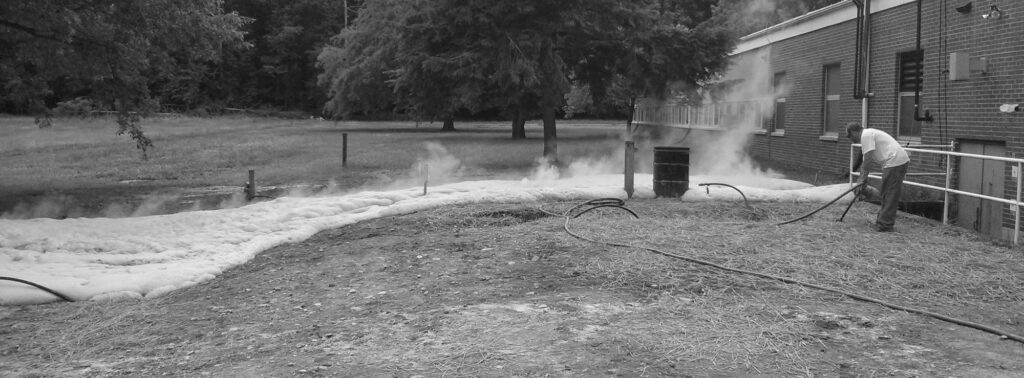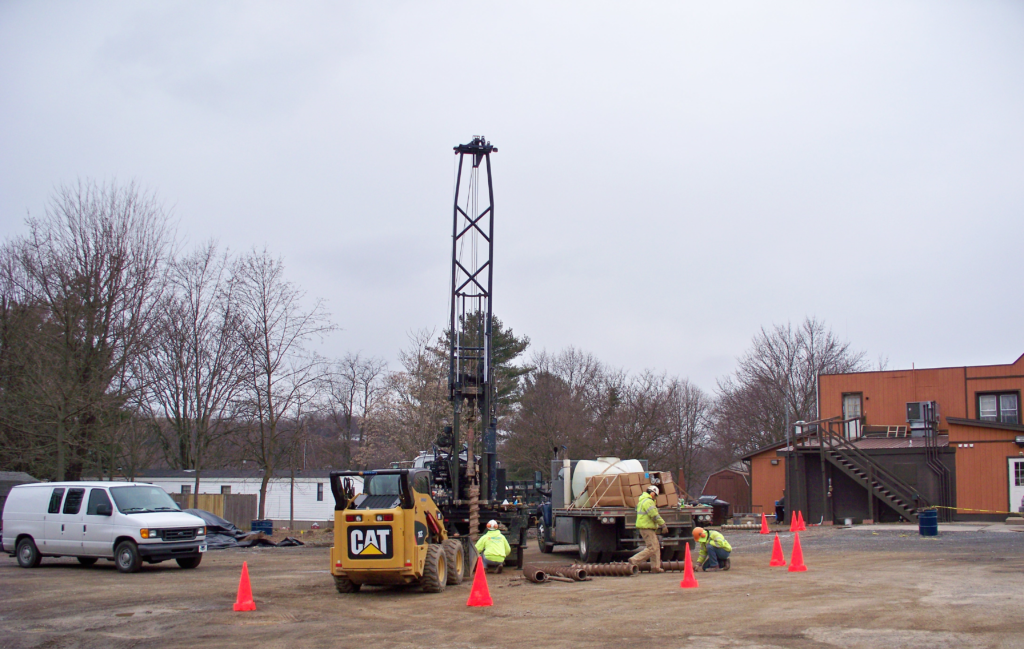Environmental & Geological Services
KCE provides Pennsylvania banking, real estate, and legal professionals, as well as commercial and industrial property owners and developers sound answers to today’s challenging environmental and geological issues. We approach everything we do, from environmental soil and groundwater investigations to geological hazard assessments, as a unique challenge. Our mission is to provide you with the best risk management tools for your site in a professional and cost-effective manner. Our success depends on the completion of your deals, and the protection of your interests. We know how to help you manage your risk and still close the deal.
KCE delivers environmental and geological solutions in a time and cost-effective manner because Pennsylvania is our focus. We understand that time savings and experience-backed problem solving add to your bottom line just as effectively as a good price. We can provide flexible turn-around times and innovative solutions.
PRACTICE AREAS
A Phase I Environmental Site Assessment (ESA) is a non-intrusive assessment of the subject property and adjacent properties that includes the following: (1) a walkover to assess the current conditions, (2) a review of historical topographic maps, fire insurance maps, city directories, and aerial photographs sources, (3) a search of government databases of sites of known environmental concern, and (4) interviews with the owners, operators, and occupants.
The goal of a Phase I ESA is to identify Recognized environmental condition, which are defined when one or more of the following conditions are met:
- The presence of hazardous substances or petroleum products in, on, or at the subject property due to a release to the environment.
- The likely presence of hazardous substances or petroleum products in, on, or at the subject property due to a release or likely release to the environment.
- The presence of hazardous substances or petroleum products in, on, or at the subject property under conditions that pose a material threat of a future release to the environment.
Although the original purpose of the Phase I ESA was to meet the “all appropriate inquiry” requirement to qualify for CERCLA liability protection, over time Phase I ESA’s have become a tool for the assessment of business risks associated with environmental contamination.
KCE performs Phase I ESAs in accordance with the requirements of the ASTM Standard E1527-21 entitled “Standard Practice for Environmental Site Assessments: Phase I Environmental Site Assessment Process.”
Pennsylvania’s Land Recycling Program encourages the recycling and redevelopment of old industrial sites (Brownfields). It sets standards by law that are protective of human health and the environment, but which consider future use.
The Land Recycling and Environmental Remediation Standards Act (Act 2) is the primary law establishing the Land Recycling Program. It creates a realistic framework for setting cleanup standards, provides special incentives for developing abandoned sites, releases responsible parties from liability when cleanup standards are met, set deadlines for Department of Environmental Protection (DEP) action and provides funding for environmental studies and cleanups.
The four cornerstones of the Land Recycling Program are uniform cleanup standards based on health and environmental risks, standardized review procedures, release from liability, and financial assistance. The three types of cleanups are background, Statewide health, and site-specific.
KCE’s approach to the Land Recycling Program is to provide the scientific services required by Act 2. Although the legislature passed Act 2 into law, scientists (including geologists, chemists, engineers, and toxicologists) established detailed framework for the law and corresponding regulations. At KCE, we provide our clients with the scientific services to obtain liability relief form the DEP.
A hydrogeologic study is an investigation of the subsurface groundwater conditions. Hydrogeologic studies may be used to evaluate the groundwater for on-lot sewage disposal systems, the development of community water systems, and for stormwater management. Data collected as part of a hydrogeologic study may include the type and thickness of geologic materials, the occurrence of groundwater, subsurface flow regime, and the quality/quantity of the groundwater.
KCE’s licensed Professional Geologist routinely performs hydrogeologic studies by developing a conceptual site model, which is a representation of the site groundwater system and the processes that control the transport and movement of groundwater through the unconsolidated and bedrock media and how they interact.
Regulated underground storage tanks (USTs) fall under Pennsylvania’s Land Recycling Program. The Storage Tank and Spill Prevention Act (Act 32), which established release reporting and corrective action requirements for owners and operators of regulated aboveground and underground storage tanks and other responsible parties. The regulations include requirements for confirming or disproving suspected releases; reporting releases; determining the extent of soil, sediment, surface water and groundwater contamination; taking necessary actions to abate risks to human health and the environment; taking steps to prevent further migration of the released substance into the environment; restoring or replacing affected or diminished water supplies; and storing contaminated soil at the site of the release.
All owners and operators of aboveground and underground storage tanks regulated under Act 32 must comply with the regulations. Furthermore, the regulations apply to releases from regulated tanks for which remediation was initiated on or after August 5th, 1989, the effective date of Act 32. Any release for which remediation was initiated before August 5th, 1989, must follow the Brownfield (Act 2) process.
Since Act 32 does not provide cleanup standards, Act 2 cleanup standards must be used. Therefore, KCE’s knowledge of Act 2 provides our clients with an advantage over most underground storage tank specialty contractors.
Much of the Lehigh Valley is underlain by carbonate bedrock. This type of bedrock is a sedimentary rock composed of carbonate materials, including calcium carbonate (CaCO3), known as limestone, and calcium magnesium carbonate (CaMg(CO3)2), known as dolomite. Both limestone and dolomite are reactive to acid. As rain is naturally slightly acidic, caused by dissolved gasses in the rain, rainwater reacts with the calcium carbonate and dissolves the rock along bedding planes and near-perpendicular joint sets, developing a karst terrain. The term karst represents both an assemblage of landforms, and a set of processes. Therefore, karst depicts not only topographic features, but also unique hydrogeological characteristics.
The solubility of these carbonate rocks often makes small fractures become large channelways; intersecting fractures become huge chambers and the normally smooth soil-bedrock interface becomes pinnacled and irregular. In the Lehigh Valley, faulted and steeply inclined bedding planes together with intersecting fractures provide secondary porosity for the flow of groundwater as well as infiltrating surface water.
Carbonate bedrock surface is usually pinnacled, and covered with a thick, weathered soil mantle. In most areas these features are hidden from view beneath the gently rolling karst landscape. During periods of drought, the soil mantle dries out and irregular shrinkage of the soil takes place. An open void may develop beneath the surface of this overlying debris, and the roof of the void assumes the shape of an arch. The weight of the compacted soil is sustained by the arch-bridge until some trigger mechanism, such as a heavy rain, causes the arch to gradually collapse, which may present itself as a closed depression on the ground surface. In other cases, the arch is of bedrock and as a subsurface solution cavity grows larger, the rock roof collapses to form a surface sinkhole.
Complex combinations of geological and hydrological influences determine which fractures are enlarged to the point that they become potential hazards. This makes the determination where voids exist within the ground, or which areas of soil will next slump or collapse into unforeseen fractures, impossible. The evaluation of published data, maps, reports, along with an onsite field investigation offers the best opportunity to minimize potential hazards.
KCE’s offers carbonate evaluations by our licensed Professional Geologist to not only protect water resources but to help mitigate geological hazards during land development.



